Chapter: Civil : Principles of Solid Mechanics : Rings, Holes, and Inverse Problems
Small Circular Holes in Plates, Tunnels, and Inclusions
Small Circular Holes in
Plates, Tunnels, and Inclusions
Small holes are often
cast or drilled in plates for everything from conduits to windows.
Corresponding situations in plane strain are tunnels or shafts. A related
question is the inclusion problem where the hole is filled with a mate-rial of
different stiffness than the plate. Rather than the normal and shear stresses
disappearing on the hole boundary, displacement conditions can be specified.
The practical design situation of lined holes falls between the two extremes of
an unreinforced hole and a rigid inclusion.
Solutions for circular
holes and inclusions are relatively straightforward in polar coordinates if the
external boundary is distant enough so that the per-turbation from the hole
essentially damps out by St. VenantŌĆÖs principle into the free field and the
boundaries do not interact. This will be the assumption in this section. For
noncircular holes or when the hole and external boundary interact, the problem
usually requires either conformal mapping with com-plex calculus, experimental
analysis, or numerical solution. We shall see, however, that, in certain
optimum design cases such as harmonic or neutral holes, some or all of these
restraints on geometry disappear.
Isotropic Field
Lam├®ŌĆÖs solution for external pressure
can be used directly for a small circular hole in an isotropic free field
(i.e., MohrŌĆÖs Circle is everywhere a point). If, as in Figure 7.2 we assume b > a, then for uniform tension, Žām,
on the external boundary, the stress function is:

Thus the effect of the hole is to
introduce purely deviatoric stress and there is no perturbation of the original
isotropic field. In other words, everywhere:

The holeŌĆÖs effect is
entirely captured in the first term of the stress function which is, itself,
harmonic. This remarkable result, as plotted in Figure 7.2, leads directly to
the design criterion for harmonic holes. That is, a harmonic hole shape is that
which does not perturb (anywhere) the isotropic compo-nent of the stress field
into which it is placed and, therefore, introduces only deviatoric stresses
everywhere.
The stresses damp out parabolically as r2.
For example, at r = 5a the
differ-ence from the original field (i.e., zero) is 4%. At the hole boundary, r = a:
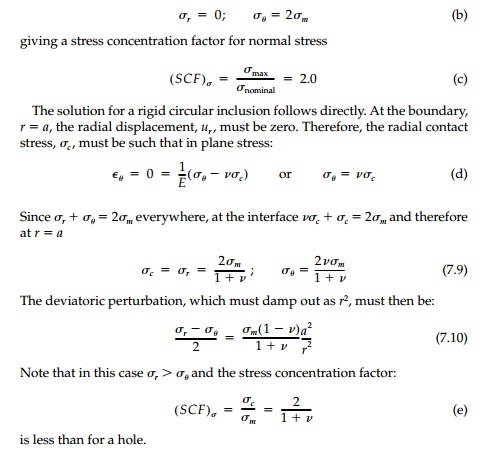
Example 7.2
A thick brass ring (b
=
2a) with internal pressure p = 6000 psi is enclosed
by a rigid boundary as shown below. Assume  12,000 psi.
12,000 psi.
(a)
Determine the stress field and plot.
(b) What
is the factor of safety against yield?

To get ahead of
ourselves, it is clear from comparing solutions for a hole and for a rigid
inclusion, that there must be some happy intermediate case where the hole
boundary is reinforced (stiffened) in such a way that there is no change in the
field stresses whatsoever. This is an optimum design that is truly optimum in
that the plate will never know there is even a hole in it. Both the isotropic and
deviatoric components are unperturbed and there is no stress concentration.
We will call this
absolute optimum a neutral hole.* In plane stress the reinforce-ment can be
provided by thickening the sheet near the boundary or by using a liner of
stiffer material. The second option is the only feasible one for plane strain.
The shape of the neutral hole in an isotropic field is certainly circular and, if we assume a liner with El>> Es, then it will be ŌĆ£thinŌĆØ. The contact stress must be Žām and the interface must move radially the same as the uncut sheet at r = a. That is:
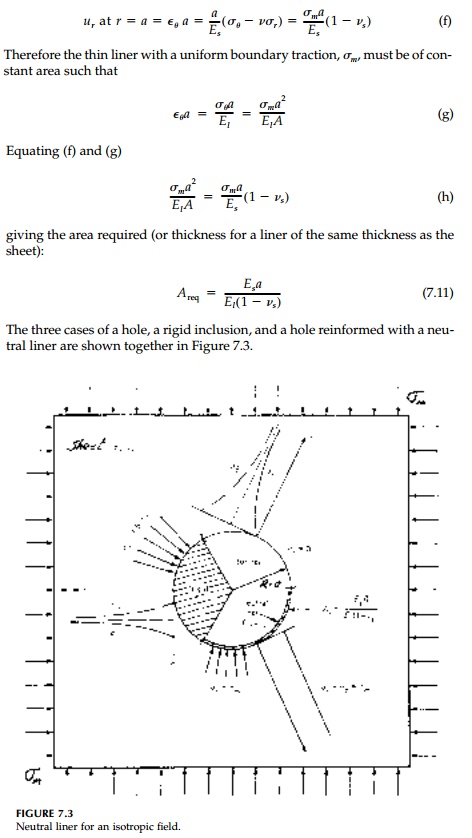
Example 7.3
Derive the solution
(stress field) for uniform pressure, p, applied to a small hole (radius = a) in a large plate.
a. Plot contours of Žāq,Žäq.
b. Is
the stress function harmonic? If so determine its conjugate and plot the flow
net.
c. Determine
the displacement field in Cartesian coordinates and plot contours of u
and v. Discuss.
d. Derive
at least one more set of conjugate harmonic functions and plot. (Hint: Consider
the equilibrium equations in Cartesian coor-dinates.)
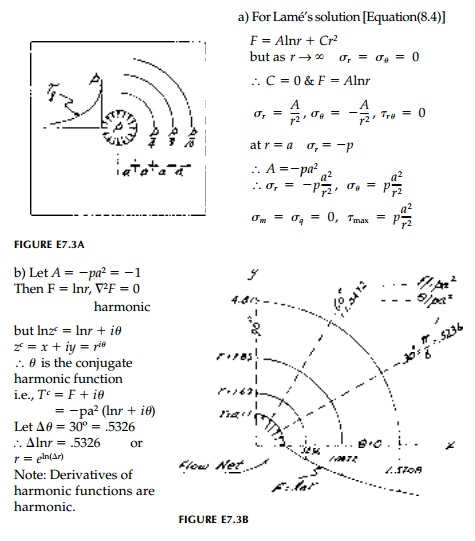
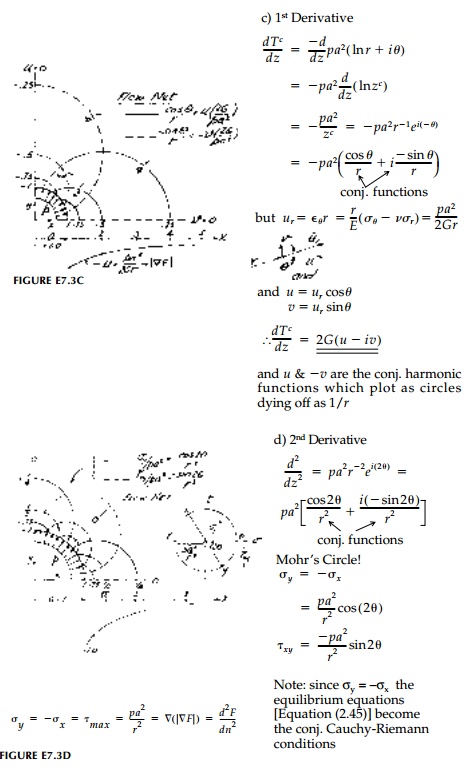
Deviatoric Field
A purely deviatoric
field, where there is no isotropic component, can be thought of as pure shear
at 45┬ o from the principal orientation. For the sheet without a hole, the
deviatoric, free-field stress function is
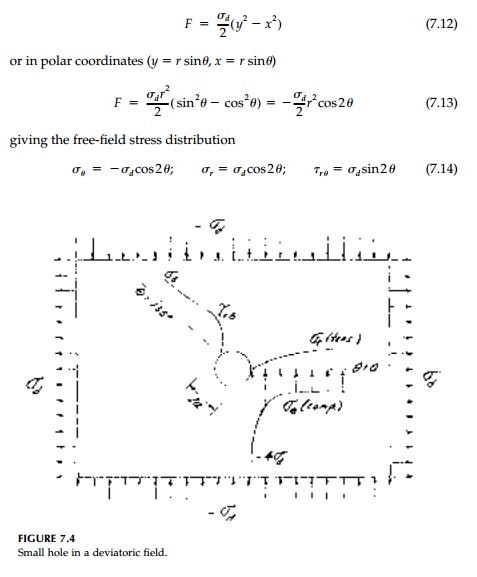
If we now drill a small
circular hole as in Figure 7.4, the perturbation must rapidly damp to this free
field and thus a stress function of type II is required with m = 2. However, the first term in the general form:

can be eliminated since
stresses would increase as r2. Therefore, assume

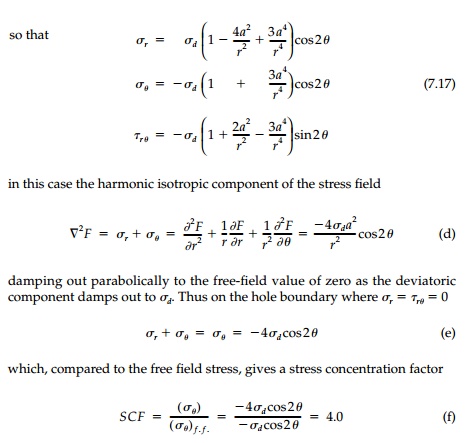
Although the stress
concentration is twice that for the isotropic case it is, as shown in Figure
7.4, much more localized.
General Biaxial Field
By superimposing
isotropic and deviatoric components in differing ratios, the stress
distribution introduced by a small hole in any biaxial field can be obtained.
The particular case of uniaxial tension, w, is shown in Figure 7.5.
Setting Žām
= Žād = w/2 the Kirsch solution for the stress field is
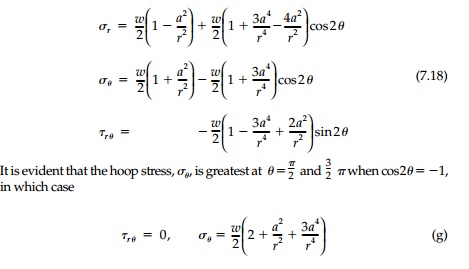
again dying away
rapidly from the hole boundary, although not quite as quickly as for the
deviatoric free field.
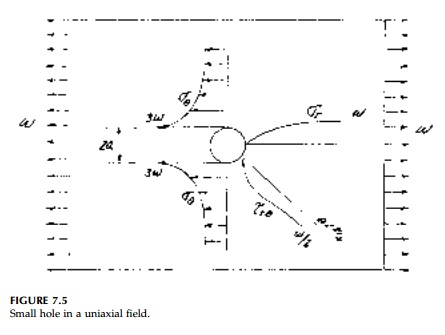
Related Topics